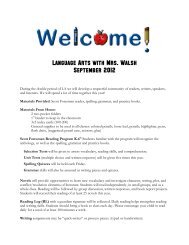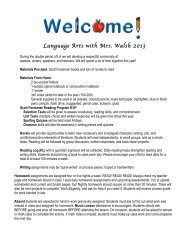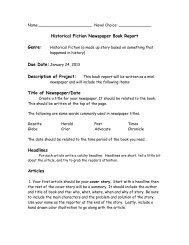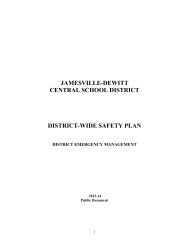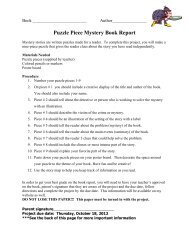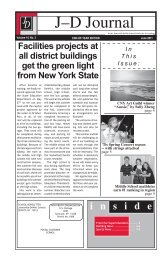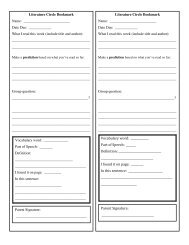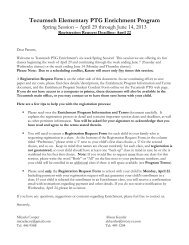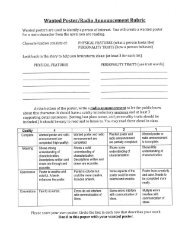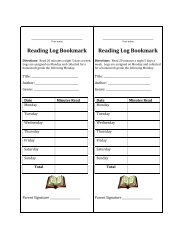the underground railroad - Jamesville-DeWitt Central School District
the underground railroad - Jamesville-DeWitt Central School District
the underground railroad - Jamesville-DeWitt Central School District
Create successful ePaper yourself
Turn your PDF publications into a flip-book with our unique Google optimized e-Paper software.
2<br />
Can you imagine being a slave? Can you imagine<br />
doing grueling, back-breaking, physical work<br />
from sunrise to sunset, day in and day out?<br />
Can you imagine having to work even if you<br />
were sick? Can you imagine being beaten for no<br />
reason? Can you imagine being sold and<br />
separated from your family? Watch <strong>the</strong> short<br />
movie (4min 51 sec) below to learn more about <strong>the</strong> slavery in <strong>the</strong> United States.<br />
http://www.brainpop.com/socialstudies/ushistory/slavery/<br />
(Username: oncoma Password:ocmsls)<br />
Do you think you would want to escape from slavery?<br />
What if you decided to try? How would you do it? You<br />
have no money. You have no food. You have nothing.<br />
Who can you trust to help you? What would you feel<br />
like wandering around in a dark swamp at night trying<br />
to escape chasing dogs and bounty hunters? Imagine<br />
being guided on how to escape by only a song entitled<br />
“Following <strong>the</strong> Drinking Gourd” (http://www.follow<strong>the</strong>drinkinggourd.org/Music/3-<br />
Foster,AlexAndMichelLarue.FollowTheDrinkingGourd.mp3).<br />
Imagine being 24 years old and having what is<br />
equivalent in today’s money to a 5000 dollar bounty<br />
on your head. Harriet Powell who escaped slavery in<br />
Syracuse, NY had just that on her head! Imagine<br />
hiding in a cupboard of a Skaneateles kitchen.<br />
Harriet Powell did just that! Read more about<br />
Harriet Powell by clicking on <strong>the</strong> link below.<br />
http://library.syr.edu/digital/exhibits/u/<strong>underground</strong>rr/case1.htm
3<br />
Purpose: The United States was founded on <strong>the</strong> principle of “all men are created<br />
equal” and “liberty for all.” Yet, <strong>the</strong> first US Census of 1790 showed almost seven<br />
hundred thousand people lived under slavery in <strong>the</strong> United States. Thousands of<br />
slaves would run from <strong>the</strong> South every year, many of <strong>the</strong>m heading North using <strong>the</strong><br />
vast network known as <strong>the</strong> Underground Railroad involving conductors, agents,<br />
pilots, stations, stockholders, and <strong>the</strong> drinking gourd. One estimate has as many as<br />
one hundred thousand slaves “lost” between 1810 and 1860. For those who chose to<br />
seek freedom, <strong>the</strong> journey was uncertain and required much endurance as well as<br />
spirit. These freedom seekers traveled thousands of miles at night under <strong>the</strong> cover<br />
of darkness guided by “drinking gourd” eluding slave catchers. The intricate complex<br />
system that took <strong>the</strong> brave North became known as <strong>the</strong> Underground Railroad. The<br />
Underground Railroad includes a network of individuals, black and white, that put<br />
<strong>the</strong>ir lives on <strong>the</strong> line for freedom. It is a compelling example of people battling<br />
injustice and seeking to improve <strong>the</strong> lives of <strong>the</strong>mselves as well as o<strong>the</strong>rs. A study of<br />
<strong>the</strong> Underground Railroad is certainly important to anyone interested in US History.<br />
Goals/Objectives: Upon completion of this unit of study, you will be able to define<br />
<strong>the</strong> Underground Railroad and explain how slaves used it to reach freedom. You will<br />
also understand its significance as well as understand its utilization. Finally, you will<br />
be able to identify at least TWO significant participants on <strong>the</strong> Underground<br />
Railroad.<br />
Materials Needed: Computer with internet access<br />
Directions: This unit of study is designed around three lessons. Each lesson<br />
requires you to read, watch, look/think, and review. Follow <strong>the</strong> prompts.
Table of Contents<br />
4<br />
Lesson 1-Introduction to <strong>the</strong> Underground Railroad 5-7<br />
Lesson 2-The Journey on <strong>the</strong> Underground Railroad 8-11<br />
Lesson 3-People of <strong>the</strong> Underground Railroad 12-14<br />
Course Evaluation 15<br />
Glossary (words in bold can be found in <strong>the</strong> glossary) 16-17<br />
Additional Resources 18<br />
Correlation to <strong>the</strong> New York State Standards 19
Lesson 1<br />
Introduction to <strong>the</strong> Underground Railroad<br />
5<br />
Guiding Question: What was <strong>the</strong> Underground Railroad?<br />
I. Read<br />
When you hear <strong>the</strong> word “<strong>railroad</strong>” what do you<br />
think of? Tracks? Steam? Loud engines?<br />
Screeching stops? A conductor? What about<br />
when hear <strong>the</strong> term Underground Railroad? Do<br />
you think of a subway? Well, <strong>the</strong> Underground<br />
Railroad was NOT an actual <strong>railroad</strong> nor was it a<br />
subway. It was a network of people!<br />
People who opposed slavery created <strong>the</strong> informal<br />
system of secrecy to help slaves escape to<br />
freedom. The Underground Railroad began towards <strong>the</strong> end of <strong>the</strong> 1700s and was<br />
labeled “The Underground Railroad” after <strong>the</strong> <strong>the</strong>n growing US <strong>railroad</strong> network.<br />
Stationmaster, conductor, pilot, and agent are all terms that refer to people who<br />
helped slaves escape to freedom. The Underground Railroad helped as many as<br />
100,000 slaves escape to freedom.<br />
II. Watch<br />
There is a link to a short movie (4min 18sec) below.<br />
The movie will serve as an introduction to <strong>the</strong><br />
Underground Railroad. Answer <strong>the</strong> questions that<br />
follow in YOUR OWN WORDS. Watch <strong>the</strong> movie as<br />
many times as you need. Take <strong>the</strong> “quiz” that follows:<br />
http://www.brainpop.com/socialstudies/ushistory/<strong>underground</strong><strong>railroad</strong>/ (username:<br />
oncoma password: ocmsls)
A. What was <strong>the</strong> Underground Railroad?<br />
6<br />
B. How did escaped slaves travel on <strong>the</strong> Underground Railroad?<br />
C. Identify a significant individual mentioned in <strong>the</strong> movie. How did he/she<br />
contribute to <strong>the</strong> Underground Railroad?<br />
III. Look/Think<br />
Look at <strong>the</strong> maps that show <strong>the</strong> various routes of <strong>the</strong> Underground Railroad. What<br />
do you notice? From where were <strong>the</strong> slaves escaping? To? Anything surprise you?<br />
\
IV. Review<br />
7<br />
http://www.quia.com/pop/534807.html?AP_rand=143282266<br />
Goals/Objectives: You should now be able to define <strong>the</strong> Underground Railroad as<br />
well as explain how slaves used <strong>the</strong> Underground Railroad to escape freedom!! If<br />
you can’t, go back and start over!
Lesson 2<br />
The Journey on <strong>the</strong> Underground Railroad<br />
8<br />
Guiding Question: What was it like traveling on <strong>the</strong> Underground Railroad?<br />
I. Read<br />
African Americans challenged slavery in a number of ways-- through mischief,<br />
rebellion, and seeking freedom. By word of mouth, coded song (“wade in water”<br />
https://www.youtube.com/watch?v=ER2b21X8dMM) and fable, enslaved people<br />
learned of <strong>the</strong> free North. For those who chose to seek freedom, <strong>the</strong> journey was<br />
uncertain and required much endurance as well as spirit. These freedom seekers<br />
traveled hundreds of miles at night under <strong>the</strong> cover of darkness guided <strong>the</strong> “drinking<br />
gourd,” eluding slave catchers. Escaping to freedom was anything but easy for a<br />
fugitive slave.<br />
Escaped slaves faced a long journey filled with fear and <strong>the</strong> possibility that <strong>the</strong>y<br />
would never reach freedom. The winter was <strong>the</strong> best time to escape because <strong>the</strong><br />
nights were long and freedom seekers moved at night, up to 20 miles. They would<br />
travel from station to station under <strong>the</strong> cover of darkness. During <strong>the</strong> day <strong>the</strong>y had<br />
to stay out of sight. They would rest and eat, hiding in secret places.<br />
The journey North was stressful. Escaped slaves had little knowledge of <strong>the</strong> land.<br />
They had little, if any money. Finding a “safe house” was often difficult. Escaped<br />
slaves often went several weeks between stations. The journey was long often<br />
several hundred miles and it took some 2 months and o<strong>the</strong>rs more than a year to<br />
reach freedom. Slave catchers with guns, horses, and dogs tracked <strong>the</strong> runaways.<br />
Freedom seekers were clever and creative. One group of escaped slaves hired a<br />
hearse and disguised <strong>the</strong>mselves as a funeral procession! One man shipped himself<br />
North in a box!
II. Watch<br />
9<br />
Participate in an Escaped Slave’s Journey<br />
The year is 1860. Click on <strong>the</strong> link<br />
below and follow a slave as he escapes<br />
on <strong>the</strong> Underground Railroad. Be sure<br />
to click on <strong>the</strong> “listen” in <strong>the</strong> upper left<br />
hand corner. This will take you<br />
approximately 10 minutes to complete.<br />
http://teacher.scholastic.com/activities/bhistory/<strong>underground</strong>_<strong>railroad</strong>/<br />
Click on <strong>the</strong> link below to participate in ano<strong>the</strong>r<br />
slave escape. This activity is an interactive escape.<br />
It will take you about 10 minutes to complete and<br />
you will make choices along <strong>the</strong> way.<br />
http://education.nationalgeographic.com/education/multimedia/interactive/<strong>the</strong><strong>underground</strong>-<strong>railroad</strong>/?ar_a=1
Answer <strong>the</strong> following questions based on your participation in BOTH “escapes.”<br />
10<br />
A. Why did some enslaved African Americans try to escape from <strong>the</strong>ir owners? Why<br />
was this such a dangerous act?<br />
B. How did most slaves travel when <strong>the</strong>y escaped? How did <strong>the</strong>y find <strong>the</strong>ir way?<br />
C. What were some of <strong>the</strong> worst dangers and challenges that runaway slaves faced?<br />
D. How did runaways try to avoid getting caught? What happened if <strong>the</strong>y were<br />
caught?<br />
E. What was <strong>the</strong> Underground Railroad? Who were <strong>the</strong> “passengers” and <strong>the</strong><br />
“conductors”?<br />
F. Why did <strong>the</strong> Underground Railroad have to be so secretive? What are some ways<br />
that people on <strong>the</strong> Underground Railroad kept <strong>the</strong>ir work – and runaway slaves –<br />
hidden?
III. Look/Think<br />
11<br />
To journey North, Henry “Box”<br />
Brown of Virginia shipped himself<br />
to freedom in 1849. The picture<br />
below shows Brown emerging from<br />
his box in Philadelphia.<br />
Frederick Douglass disguised himself as a sailor and<br />
boarded a train North. The train took him to NYC and<br />
freedom! He eventually settled in Rochester, NY.<br />
IV. Review<br />
http://www.quia.com/pop/534873.html<br />
Goals/Objectives: You should now be able to explain <strong>the</strong> many ways in which<br />
escaped slaves utilized <strong>the</strong> Underground Railroad to reach freedom. If you<br />
can’t, start <strong>the</strong> lesson over!
Lesson 3<br />
People of <strong>the</strong> Underground Railroad<br />
12<br />
Guiding Question: Who were <strong>the</strong> heroes of <strong>the</strong> Underground Railroad?<br />
I. Read<br />
It took many people to make <strong>the</strong> Underground Railroad<br />
work. People broke <strong>the</strong> law to help freedom seekers. This<br />
portrait of people includes both men and women, all of whom<br />
put <strong>the</strong>ir lives on <strong>the</strong> line for freedom. The story of <strong>the</strong><br />
Underground Railroad is an epic one of <strong>the</strong> love and<br />
humanity of people.<br />
Harriet Tubman was one of <strong>the</strong> most famous conductors on<br />
<strong>the</strong> Underground Railroad. She escaped slavery and <strong>the</strong>n<br />
helped over 300 slaves to freedom. She was nicknamed<br />
Moses. Tubman ultimately settled in Auburn, New York.<br />
<strong>Central</strong> New York became a promising and popular haven for many fugitives and was<br />
well-established in part because of CNY’s unique system of transportation as well as<br />
<strong>the</strong> many citizens who were willing to challenge <strong>the</strong> law. In Syracuse, NY Harriet<br />
Powell and Jerry Henry were two escaped slaves who were helped to Canada for<br />
freedom. The local stationmaster in Syracuse, Jermain Loguen helped plan Jerry<br />
Henry’s escape and often took slaves from Harriet Tubman so <strong>the</strong>y could be housed<br />
and fed.<br />
Matilda Joslyn Gage, offered her Fayetteville, NY home as a station on <strong>the</strong><br />
Underground Railroad in defiance of federal law (<strong>the</strong> Fugitive Slave Act). She<br />
could have been fined 1,000 dollars (23,000 dollars today) and spent 6 months in jail<br />
for this public proclamation. Abolitionists such as Gage were willing to risk fines and<br />
prison to care for <strong>the</strong> safety of slaves on <strong>the</strong>ir journey to freedom in <strong>the</strong> North.
II. Watch<br />
13<br />
There is a link to a short movie (7min 27sec) below. It is a<br />
mini-biography of Harriet Tubman who led hundreds of<br />
escaped slaves to freedom on <strong>the</strong> Underground Railroad.<br />
https://www.youtube.com/watch?v=XmsNGrkbHm4&feature=fvst<br />
In <strong>the</strong> space below draw a picture of Harriet Tubman helping an escaped slave to<br />
freedom. Use color!<br />
There is a link below to a short movie (2min 49sec) on<br />
Frederick Douglass. As <strong>the</strong> movie progresses, list 5 things<br />
you learn about Frederick Douglass.<br />
1.<br />
2.<br />
3.<br />
4.<br />
5.<br />
https://www.youtube.com/watch?v=Su-4JBEIhXY&feature=relmfu
14<br />
III. Look/Think<br />
William Still is sometimes called <strong>the</strong> “fa<strong>the</strong>r of<br />
<strong>the</strong> Underground Railroad.” He kept careful<br />
notes on all <strong>the</strong> people he helped to freedom.<br />
The “notes” were eventually published.<br />
The Grimke sisters of South Carolina lived on a<br />
family plantation that had slaves. They secretly<br />
taught <strong>the</strong> slaves to read and write.<br />
IV. Review<br />
http://www.quia.com/pop/534883.html<br />
Goals/Objectives: You should now be able to identify at least TWO individuals<br />
who risked <strong>the</strong>ir lives to help o<strong>the</strong>rs on <strong>the</strong> Underground Railroad. If you can’t,<br />
start <strong>the</strong> lesson over!
Course Survey<br />
15<br />
Please take a moment to complete <strong>the</strong> following course survey. Without responsible<br />
participant input this unit of study cannot effectively be assessed and improved. You<br />
are encouraged to be honest, fair, and constructive as you complete this important<br />
process. Your constructive, confidential, and anonymous feedback is very much<br />
appreciated.<br />
http://www.surveymonkey.com/s/VVM5YSG
Glossary<br />
16<br />
Abolitionist: someone who wanted slavery to end<br />
Agent: an individual who helped an escaped slave along <strong>the</strong> Underground Railroad<br />
Baggage: a freedom seeker<br />
Bundles of Wood: fugitives to be expected<br />
Conductor/Agent: an individual who helped an escaped slave along <strong>the</strong> Underground<br />
Railroad<br />
Drinking Gourd: refers to <strong>the</strong> Big Dipper, which includes <strong>the</strong> North Star. The<br />
“drinking gourd” guided freedom seekers as <strong>the</strong>y travelled to freedom.<br />
Freedom Seeker: an escaped slave who risked life and limb to travel North to<br />
freedom<br />
Freedom Train: The Underground Railroad<br />
Fugitive: a runaway slave<br />
Fugitive Slave Act 1850: passed by <strong>the</strong> United States Congress to provide for <strong>the</strong><br />
return of slaves who escaped…<strong>the</strong> law punished those who helped runaway slaves.<br />
Moses: Harriet Tubman, a “conductor” who aided escaping slaves and was a former<br />
slave<br />
North Star: <strong>the</strong> star known as “Polaris” which escaped slaves relied on as <strong>the</strong>ir main<br />
navigational tool to freedom<br />
Passengers/Freight/Cargo: a freedom seeker, an escaped slave<br />
River Jordan: The Mississippi or <strong>the</strong> Ohio River<br />
Shepherds: people who escorted freedom seekers
17<br />
Station Master: <strong>the</strong> keeper of a safe-house or “station”<br />
Station: a safe-house and temporary refuge where freedom seekers hid along <strong>the</strong><br />
Underground Railroad. Churches, barns, boats, houses, etc all served as statrions.<br />
Stockholder: a person who donated money, clothing and/or food to <strong>the</strong> Underground<br />
Railroad<br />
Underground Railroad: a “secret” network to help runaway slaves escape freedom
Additional Resources<br />
18<br />
The Underground Railroad Freedom Center<br />
http://www.<strong>underground</strong><strong>railroad</strong>.org<br />
The Underground Railroad<br />
http://www.pbs.org/wgbh/aia/part4/4p2944.html<br />
Harriet Tubman<br />
http://www.nyhistory.com/harriettubman/life.htm<br />
http://www.harriethouse.org/<br />
McDonough, Yona. Who Was Harriet Tubman. Turtleback Books 2003<br />
William “Jerry” Henry<br />
http://www.nyhistory.com/gerritsmith/jerry.htm<br />
http://syracuse<strong>the</strong>nandnow.org/Dwntwn/ClintonSq/JerryRescue.htm<br />
http://query.nytimes.com/mem/archivefree/pdf?res=9804E0DF1438E334BC4B51DFB6678389649FDE<br />
Matilda Joslyn Gage<br />
http://www.matildajoslyngage.org/gage-home/bringing-gage-to-life/whowas-matilda-joslyn-gage/<br />
http://www.nyhistory.com/gagepage/<br />
http://www.northnet.org/stlawrenceaauw/gage.htm<br />
New York State and <strong>the</strong> Underground Railroad<br />
Sernet, Milton C. North Start Country: Upstate New York and <strong>the</strong> Crusade<br />
for African American Freedom. Syracuse University Press 2002<br />
http://www.pacny.net/freedom_trail/<br />
Songs of Freedom<br />
Music played an important part in <strong>the</strong> Underground Railroad. Fleeing slaves often<br />
sang spirituals (religious songs) with secret messages about <strong>the</strong> Underground<br />
Railroad. Codes within <strong>the</strong> songs told slaves when, how, and where to escape. Check<br />
out some of <strong>the</strong>ir songs…..<br />
http://www.osblackhistory.com/songs.php
The New York State Standards<br />
19<br />
This self-study unit is correlated to <strong>the</strong> New York State Standards in Social Studies<br />
and Language Arts.<br />
Social Studies<br />
Standard 1: History of <strong>the</strong> United States and New York<br />
Students will use a variety of intellectual skills to demonstrate <strong>the</strong>ir understanding<br />
of major ideas, eras, <strong>the</strong>mes, developments, and turning points in <strong>the</strong> history of <strong>the</strong><br />
United States and New York<br />
Standard 5: Civics, Citizenship, and Government<br />
Students will use a variety of intellectual skills to demonstrate <strong>the</strong>ir understanding<br />
of <strong>the</strong> necessity for establishing governments; <strong>the</strong> governmental system of <strong>the</strong><br />
United States and o<strong>the</strong>r nations; <strong>the</strong> United States Constitution; <strong>the</strong> basic civic<br />
values of American constitutional<br />
democracy; and <strong>the</strong> roles, rights, and responsibilities of citizenship, including avenues<br />
of participation.<br />
English Language Arts<br />
Standard 1: Language for Information and Understanding Students will listen, speak,<br />
read, and write for information and understanding. As listeners and readers,<br />
students will collect data, facts, and ideas; discover relationships, concepts, and<br />
generalizations; and use knowledge generated from oral, written, and electronically<br />
produced texts. As speakers and writers, <strong>the</strong>y will use oral and written language that<br />
follows <strong>the</strong> accepted conventions of <strong>the</strong> English language to acquire, interpret, apply,<br />
and transmit information.<br />
Standard 3: Language for Critical Analysis and Evaluation<br />
Students will listen, speak, read, and write for critical analysis and evaluation. As<br />
listeners and readers, students will analyze experiences, ideas, information, and<br />
issues presented by o<strong>the</strong>rs using a variety of established criteria. As speakers and<br />
writers, <strong>the</strong>y will use oral and written language that follows <strong>the</strong> accepted conventions<br />
of <strong>the</strong> English language to present, from a<br />
variety of perspectives, <strong>the</strong>ir opinions and judgments on experiences, ideas,<br />
information and issues.



